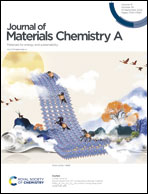Achieving high-rate and high-capacity Zn metal anodes via a three-in-one carbon protective layer†
Abstract
The long-standing dendrite and side reaction issues on Zn anodes largely impede the further development of aqueous zinc-ion batteries (AZIBs). Building artificial interface layers is an effective approach to alleviate these problems. However, traditional interface coatings are limited in achieving stable and high-performance Zn anodes at a high deposition rate and capacity. Herein, a three-in-one artificial layer of three-dimensional porous N-doped carbon (3D-NC) on Zn anodes (3D-NC@Zn) is proposed to improve Zn deposition qualities. Density functional theory (DFT) theoretical calculations and molecular dynamics (MD) simulations demonstrate that the 3D-NC layer provides favorable Zn adsorption sites, uniformizes the surface electrical field, and redistributes the Zn2+ flux to induce smooth and fast Zn deposition. Consequently, the 3D-NC layer enables Zn symmetric cells with an extended lifespan of 1300 h at high current density (10 mA cm−2) and high areal capacity (10 mA h cm−2). Besides, the 3D-NC@Zn|VO2 full batteries exhibit a high capacity retention of 82.7% after over 1000 cycles at 1 A g−1 and a discharge capacity retention of 64.7% after 200 cycles at 0.1 A g−1 in the 1.12 Ah-pouch cell. This work opens the door for designing multi-functional interfacial layers to achieve high-performance and highly reversible Zn metal anodes.



 Please wait while we load your content...
Please wait while we load your content...